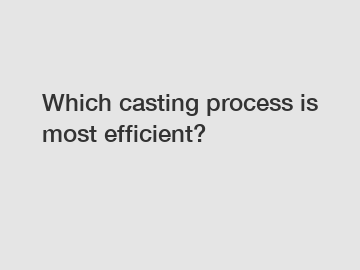Which casting process is most efficient?
Which Casting Process is Most Efficient?
In the manufacturing industry, casting refers to the process of creating a solid object by pouring liquid material, typically metal or plastic, into a mold and allowing it to cool and harden. This process is widely used across various industries, including automotive, aerospace, and consumer goods. However, with multiple casting methods available, it becomes crucial to determine which process is the most efficient. In this article, we will explore the efficiency of different casting processes and their respective advantages.
Investment Casting:

Investment casting, also known as lost-wax casting, is a highly versatile process that has been employed for centuries. It involves creating a wax model of the desired object, coating it with several layers of ceramic material, and then melting the wax to create a cavity. Molten metal is then poured into the mold, filling the cavity. The main advantage of investment casting is its ability to produce highly intricate and detailed objects. This process is particularly suitable for small production runs and complex shapes that are challenging to achieve through other methods.
Die Casting:
Die casting is a process where molten metal is forced into a mold cavity under high pressure. Once the metal solidifies, the mold is opened, and the casting is ejected. This method allows for the production of consistently shaped parts with excellent surface finishes. Die casting is widely used in the automotive and appliance industries due to its ability to create complex parts quickly and with high precision. The efficiency of die casting lies in its ability to produce large quantities of parts in a short amount of time, making it ideal for mass production.
Sand Casting:
Sand casting is one of the oldest casting methods and remains widely used today. This process involves creating a mold from a mixture of sand and a binder, which is then packed around a pattern. Once the mold is removed, molten metal is poured into the cavity. Sand casting is highly versatile and can be used to produce both large and small parts. It is also cost-effective, as the materials used for the mold are readily available and inexpensive. However, sand casting has some drawbacks, such as lower dimensional accuracy and longer production time compared to other casting methods.
Gravity Casting:
Gravity casting, also known as permanent mold casting, utilizes gravity to fill the mold with molten metal. The process involves pouring the liquid material into a permanent mold, allowing it to solidify, and then removing the casting. Gravity casting offers good surface finish and dimensional accuracy, making it suitable for applications where precision is essential. It is commonly used for manufacturing components such as engine pistons, pump housings, and various aluminum parts. The efficiency of gravity casting lies in its ability to produce parts with consistent quality and minimal post-processing requirements.
Conclusion:
Determining the most efficient casting process depends on various factors, including the desired shape and complexity of the object, the required precision, and the expected production volume. Investment casting excels in producing intricate objects, while die casting provides high productivity for mass production. Sand casting remains a cost-effective option for both small and large parts, while gravity casting offers excellent dimensional accuracy. Ultimately, the most efficient casting process will vary based on the specific needs of the manufacturing project.
For more information on casting processes and to discuss the most suitable method for your manufacturing needs, please don't hesitate to contact us.
Keywords: contact us.
Contact us to discuss your requirements of Lost foam casting process training, Automatic lost foam casting production line, How much does the lost foam casting equipment. Our experienced sales team can help you identify the options that best suit your needs.


